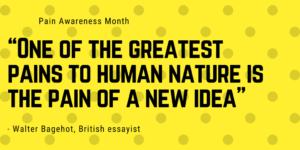Pain Awareness Month

The word elicits a number of images and feelings. Whether physical, emotional, current or past, pain is part of the human experience. There are thousands of wise quotes about handling pain, surviving pain, helping others through pain, and learning from pain. Since we are just coming to the end of September, which since 2001 has been deemed “Pain Awareness Month”, let’s delve into the pain associated with wounds.
Pain is a very complex concept filled with many factors that affect its severity and impact: Stub your toe in the middle of the night as you are getting out of bed and you will most likely cry out in pain (unless you are nice to your mate). Stub your toe in the middle of a battlefield and most likely you will not even notice it. A tiny paper cut can be very annoying and painful with acute pain, changing the way you use your hand for the day. But a large diabetic foot wound can sometimes not be painful at all.
The purpose of pain is to warn that something is going wrong in the body. It can be in the form of discomfort, burning, stabbing, aching, constant or intermittent, but we had better pay attention to finding out why it is there. It could save your life or limb.
All types of wounds can have pain. Whether it is a pressure injury, trauma, surgical wound, venous ulcer, diabetic neuropathic ulcer, or inflammatory wound, all wounds can cause debilitating and prolonged effects due to the tissue injury and responses. There is never any reason to minimize the impact of pain. All pain is personal and all pain is perceived differently based on many non-physical factors such as context, prior experience, cognition, suffering, anxiety, and emotions.
The types of wound-related pain have been studied extensively. Krasner1 has developed a conceptual model that spells these out. There can be acute pain with a new injury, chronic pain associated usually with the underlying cause of the wound, cyclical pain associated with periodic acute pain (like dressing changes or position changes), and non-cyclical pain associated with irregular events such as a sharp debridement or occasional procedure.
So what do we do? How does a person overcome the presence of a painful wound with certain activities or as an undertone to all activities? How does a clinician assist someone to manage the wound and the pain associated thereof? We turn to Oprah, of course!
For both the patient and the clinician, finding ways to minimize pain is paramount. There are several strategies to employ. First of all, remove the local cause of pain if at all possible. If wound pain is caused by pressure, remove it! Get the proper bed or seating equipment; get properly fitting shoes or braces to offload the wound site. Look for dressings that minimize trauma to the wound bed while still creating a moist wound environment for healing. There are silicone-based foams, meshes, or gelling products that are appropriate for many wounds. Ease removal of these products by coming up with strategies at dressing changes that will minimize the acute cyclical or episodic pain. Look systemically at the cause of the wounds (which the wound treatment should include anyway). Compressing a venous ulcer and reducing swelling can minimize the pain as the cause is addressed.
Most people with wounds expect that there will be some pain. In addition, even the stress associated with wound pain can affect the progress of wounds. The burden and the privilege in wound management therefore must focus on limiting the suffering associated with treatment of these wounds. Clinicians and patients can partner together to use pain relieving dressings, medications (both topical and systemic), movement patterns, pressure relieving equipment, and mindfulness strategies to lessen and endure these experiences. As the wounds become smaller and the cause is managed, then hopefully the pain will also lessen or disappear.
One of the newer findings in the approach to pain management in wounds is the use of continuous diffusion of oxygen (CDO). CDO delivers oxygen using the same basic mechanism as breathing: direct diffusion of oxygen into the wound from a moist wound therapy dressing. This is a wearable technology (TransCu O2) using room air to deliver pure oxygen via tubing to the wound dressing. In studying the effects of this device on wound healing, the results included significant healing AND a significant reduction of pain, even during the first several days of treatment.2 Out of 20 patients, 90% of them experienced noticeable pain relief in the first week. One patient in particular had experienced significant trauma with each dressing change. Her wound had been present for over a year. It was a small wound, but quite painful. She was terrified each time the wound clinician came to change her dressing. After the first treatment with CDO, experiencing the dressing change with very little pain, she exclaimed, “I have lost my fear”. Her wound went on to close in 39 days. Now those words are worth quoting.
All pain can be debilitating or life changing. So no matter if you are suffering from the pain of a stumped toe or the neuropathy of a chronic foot ulcer, this September we are mindful of the pain associated with wounds and the people dealing with such pain. May they lose their fear of chronic pain and turn their wounds into wisdom.
This blog post was written by Robin Carlson, PT CWS
What is PT CWS? Physical Therapist and Certified Wound Specialist






